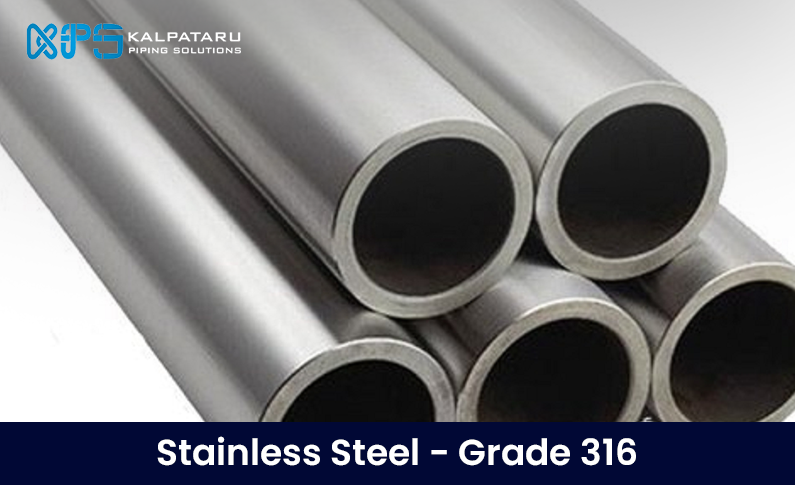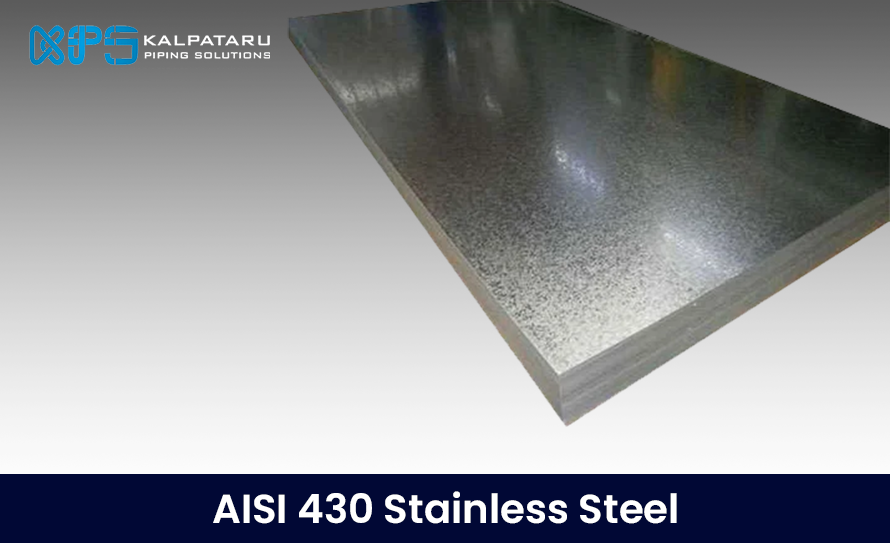Grade 316 is a standard molybdenum-bearing stainless steel, second only to 304 among austenitic stainless steels. The molybdenum enhances its corrosion resistance, especially in chloride environments, offering better overall protection against pitting and crevice corrosion compared to Grade 304. This grade also has excellent forming and welding characteristics, making it easy to shape and weld into various parts for industrial, architectural, and transportation applications. Importantly, post-weld annealing is not necessary when welding thin sections of 316 stainless steel.
Grade 316L is the low carbon version of 316 and is resistant to sensitization , making it ideal for heavy gauge welded components over about 6mm. Grade 316H, with higher carbon content, is suited for elevated temperature applications, while stabilized grade 316Ti also performs well at high temperatures.
The austenitic structure of these grades provides excellent toughness, even down to cryogenic temperatures, making them versatile and reliable in various applications.
What is Stainless Steel 316?
Stainless steel is a steel alloy containing at least 10% chromium, which provides corrosion resistance. The addition of chromium creates a thin film of metal oxide on the surface, protecting against corrosive materials.
Stainless steel 316 is a popular grade known for its enhanced corrosion resistance. It typically consists of 16 to 18% chromium, 10 to 14% nickel, 2 to 3% molybdenum, and a small percentage of carbon. The presence of molybdenum increases its corrosion resistance compared to other stainless steel grades. The addition of other alloys further enhances its properties & Applications.
Due to its excellent properties and characteristics, stainless steel 316 is the second-most widely used stainless steel grade after 304. It is commonly used in corrosive environments such as chemical plants, refineries, and marine equipment. The superior resistance to pitting and crevice corrosion makes it ideal for applications exposed to chloride and saline environments.
Key Properties
These properties are specified for flat rolled products (plate, sheet, and coil) in ASTM A240/A240M. Similar, though not necessarily identical, properties are specified for other products like pipe and bar in their respective specifications.
316 Grade Specification Comparison
|
Grade |
UNS No |
Old British |
Euronorm |
Swedish SS |
Japanese JIS |
||
|
BS |
En |
No |
Name |
||||
|
316 |
S31600 |
316S31 |
58H, 58J |
1.4401 |
X5CrNiMo17-12-2 |
2347 |
SUS 316 |
|
316L |
S31603 |
316S11 |
– |
1.4404 |
X2CrNiMo17-12-2 |
2348 |
SUS 316L |
|
316H |
S31609 |
316S51 |
– |
– |
– |
– |
– |
Mechanical Properties of Stainless Steel 316
|
Grade |
Tensile Str (MPa) min |
Yield Str 0.2% Proof (MPa) min |
Elong (% in 50 mm) min |
Hardness |
|
|
Rockwell B (HR B) max |
Brinell (HB) max |
||||
|
316 |
515 |
205 |
40 |
95 |
217 |
|
316L |
485 |
170 |
40 |
95 |
217 |
|
316H |
515 |
205 |
40 |
95 |
217 |
Chemical Composition of Stainless Steel 316 Grade
|
Grade |
|
C |
Mn |
Si |
P |
S |
Cr |
Mo |
Ni |
N |
|
316 |
Min |
– |
– |
– |
0 |
– |
16.0 |
2.00 |
10.0 |
– |
|
Max |
0.08 |
2.0 |
0.75 |
0.045 |
0.03 |
18.0 |
3.00 |
14.0 |
0.10 |
|
|
316L |
Min |
– |
– |
– |
– |
– |
16.0 |
2.00 |
10.0 |
– |
|
Max |
0.03 |
2.0 |
0.75 |
0.045 |
0.03 |
18.0 |
3.00 |
14.0 |
0.10 |
|
|
316H |
Min |
0.04 |
0.04 |
0 |
– |
– |
16.0 |
2.00 |
10.0 |
– |
|
max |
0.10 |
0.10 |
0.75 |
0.045 |
0.03 |
18.0 |
3.00 |
14.0 |
– |
Stainless Steel – Grade 316 (UNS S31600)
| Material: | Stainless Steel – Grade 316 (UNS S31600) |
| Composition: | Fe/<.03C/16-18.5Cr/10-14Ni/2-3Mo/<2Mn/<1Si/<.045P/<.03S |
| Property | Minimum Value (S.I.) | Maximum Value (S.I.) | Units (S.I.) | Minimum Value (Imp.) | Maximum Value (Imp.) | Units (Imp.) |
| Atomic Volume (average) | 0.0069 | 0.0072 | m3/kmol | 421.064 | 439.371 | in3/kmol |
| Density | 7.87 | 8.07 | Mg/m3 | 491.308 | 503.794 | lb/ft3 |
| Energy Content | 91 | 111 | MJ/kg | 9858.82 | 12025.6 | kcal/lb |
| Bulk Modulus | 134 | 152 | GPa | 19.435 | 22.0457 | 106 psi |
| Compressive Strength | 170 | 310 | MPa | 24.6564 | 44.9617 | ksi |
| Ductility | 0.3 | 0.51 | 0.3 | 0.51 | NULL | |
| Elastic Limit | 170 | 310 | MPa | 24.6564 | 44.9617 | ksi |
| Endurance Limit | 256 | 307 | MPa | 37.1296 | 44.5265 | ksi |
| Fracture Toughness | 112 | 278 | MPa.m1/2 | 101.925 | 252.993 | ksi.in1/2 |
| Hardness | 1700 | 2200 | MPa | 246.564 | 319.083 | ksi |
| Loss Coefficient | 0.00095 | 0.00148 | 0.00095 | 0.00148 | NULL | |
| Modulus of Rupture | 170 | 310 | MPa | 24.6564 | 44.9617 | ksi |
| Poisson’s Ratio | 0.265 | 0.275 | 0.265 | 0.275 | NULL | |
| Shear Modulus | 74 | 82 | GPa | 10.7328 | 11.8931 | 106 psi |
| Tensile Strength | 480 | 620 | MPa | 69.6181 | 89.9234 | ksi |
| Young’s Modulus | 190 | 205 | GPa | 27.5572 | 29.7327 | 106 psi |
| Glass Temperature | K | °F | ||||
| Latent Heat of Fusion | 260 | 285 | kJ/kg | 111.779 | 122.527 | BTU/lb |
| Maximum Service Temperature | 1023 | 1198 | K | 1381.73 | 1696.73 | °F |
| Melting Point | 1648 | 1673 | K | 2506.73 | 2551.73 | °F |
| Minimum Service Temperature | 0 | 0 | K | -459.67 | -459.67 | °F |
| Specific Heat | 490 | 530 | J/kg.K | 0.379191 | 0.410145 | BTU/lb.F |
| Thermal Conductivity | 13 | 17 | W/m.K | 24.3364 | 31.8246 | BTU.ft/h.ft2.F |
| Thermal Expansion | 15 | 18 | 10-6/K | 27 | 32.4 | 10-6/°F |
| Breakdown Potential | MV/m | V/mil | ||||
| Dielectric Constant | NULL | |||||
| Resistivity | 69 | 81 | 10-8 ohm.m | 69 | 81 | 10-8 ohm.m |
Possible Alternative stainless steel Grades
|
Grade |
Other stainless steel Grade of 316 |
|
316Ti |
Better resistance to temperatures of around 600-900 °C is needed. |
|
316N |
Higher strength than standard 316. |
|
317L |
Higher resistance to chlorides than 316L, but with similar resistance to stress corrosion cracking. |
|
904L |
Much higher resistance to chlorides at elevated temperatures, with good formability |
|
2205 |
Much higher resistance to chlorides at elevated temperatures, and higher strength than 316 |
Corrosion Resistance
Grade 316 stainless steel offers excellent resistance in a variety of atmospheric environments and corrosive media, surpassing the resistance of Grade 304. It is generally resistant to potable water with up to about 1000 mg/L chlorides at ambient temperatures, reducing to about 500 mg/L at 60 °C. 316 stainless steel is often considered the standard “marine grade stainless steel,” but it is not resistant to warm sea water. In many marine environments, 316 can exhibit surface corrosion, often visible as brown staining. This is particularly common in crevices and on rough surfaces.
Heat Resistance
Grade 316 stainless steel has good oxidation resistance in intermittent service up to 870 °C and in continuous service up to 925 °C. However, continuous use of 316 in the 425-860 °C range is not recommended if subsequent aqueous corrosion resistance is important. Grade 316L is more resistant to carbide precipitation and can be used within this temperature range. Grade 316H, with its higher carbon content, has higher strength at elevated temperatures and is sometimes used for structural and pressure-containing applications at temperatures above about 500 °C.
Heat Treatment
Heat Treatment For solution treatment (annealing), heat to 1010-1120°C and cool rapidly. These 316 grades cannot be hardened by thermal treatment.
Welding
Welding Excellent weldability is achievable using all standard fusion methods, both with and without filler metals. AS 1554.6 pre-qualified welding of 316 with 316 rods or electrodes, and 316L with 316L rods or their high silicon equivalents. Heavy welded sections in Grade 316 require post-weld annealing for optimal corrosion resistance, which is not necessary for 316L. Grade 316Ti can also be used as an alternative for heavy section welding.
Machining
Kalpataru Piping Solutions offers an improved machinability version of Grade 316, available in round and hollow bar products. This version machines significantly better than standard 316 or 316L, providing higher machining rates and lower tool wear in many operations.
Summary
Grade 316 stainless steel, including its variants 316L and 316H, provides superior corrosion resistance, excellent heat resistance, and outstanding welding and machining properties. Its versatility and robust performance make it ideal for a wide range of industrial, architectural, and marine applications.
FAQs
What is 316 stainless steel pipe?
316 stainless steel pipe offers superior corrosion resistance and can withstand higher temperatures compared to grade 304/304L. It also provides excellent weldability. Common applications include chemical containers, pressure vessels, and industrial equipment.
What is Stainless Steel - Grade 316 ?
Stainless Steel – Grade 316: Grade 316 is an austenitic stainless steel, ranked second to 304 in commercial importance. It contains molybdenum, which enhances its corrosion resistance, especially against pitting and crevice corrosion in chloride environments.
What is stainless steel angle grade 316?
Stainless steel angle grade 316 is known for its high strength and excellent corrosion resistance, including in marine environments. It is slightly stronger than 304 stainless steel and is rated as a marine metal. Grade 316 maintains its properties at both cryogenic and high temperatures.




